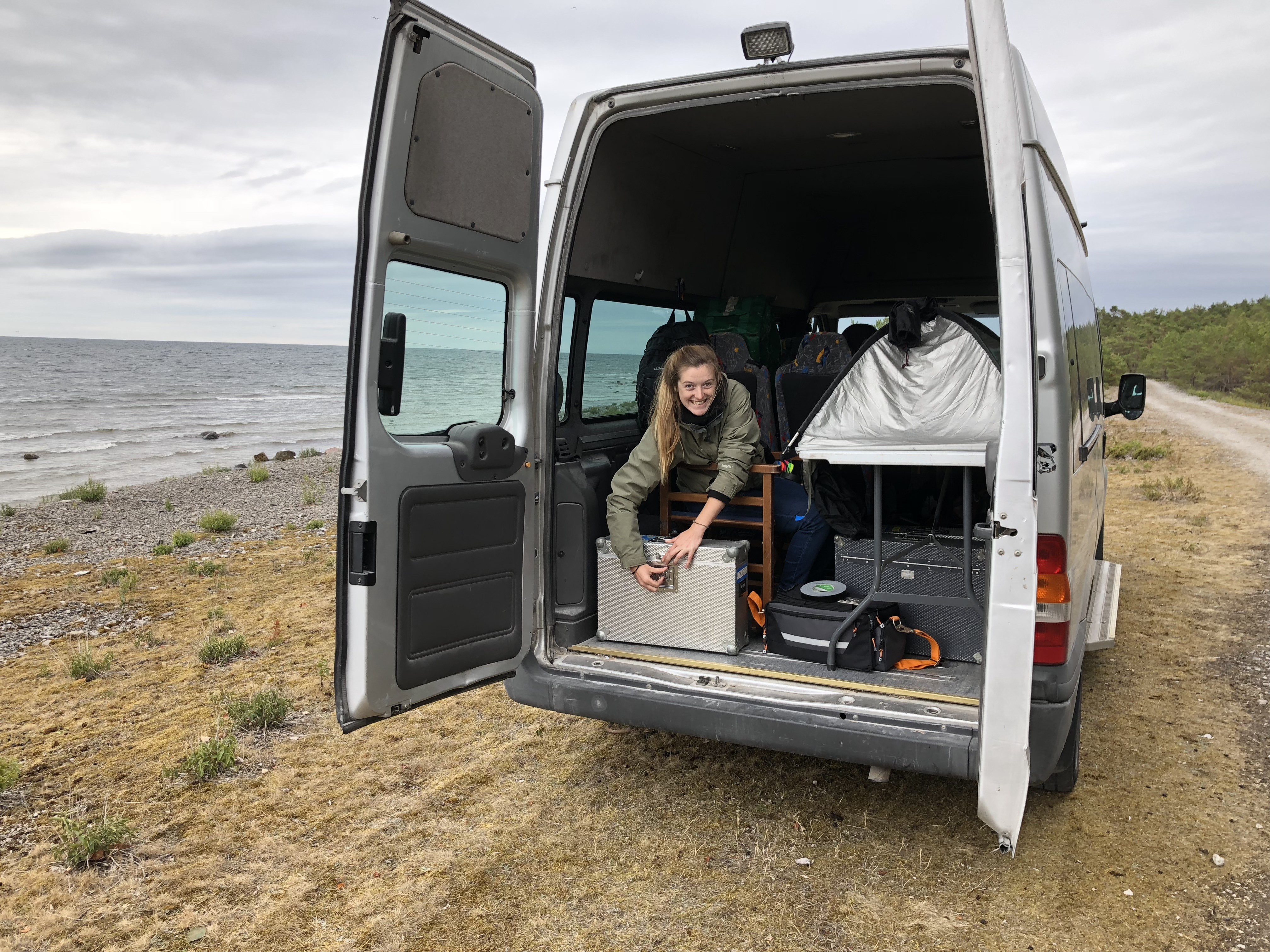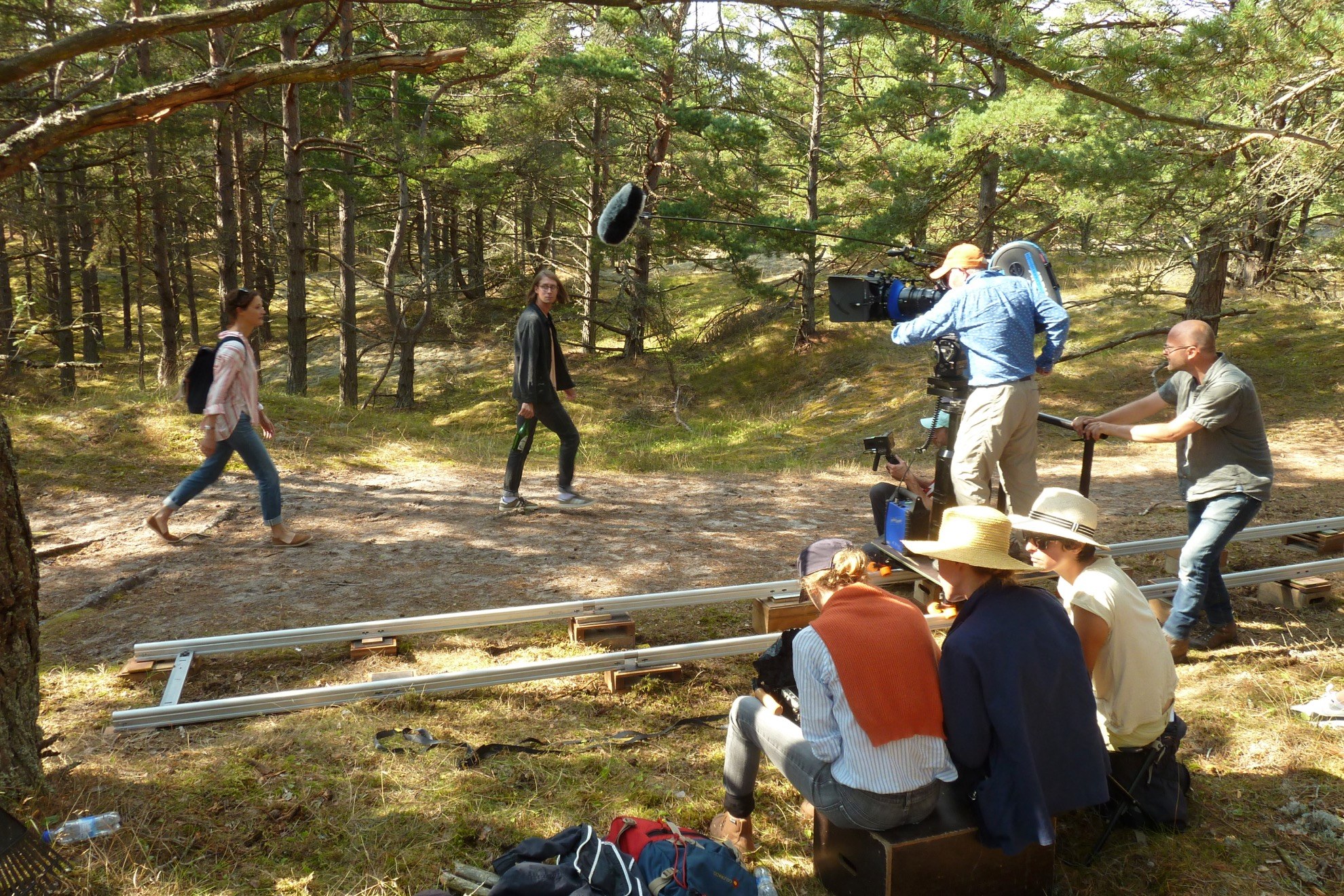
Bergman Island Journal — Part V
The cinematographer’s updates on the making of this unique project set on Fårö, the Swedish island where Ingmar Bergman shot four features, lived, died and is buried.
Production images courtesy of the author
Editor’s note: This production diary will unfold over the following days in multiple parts (starting here), while a more formal interview with the cinematographer can be found here.
Week 2
Monday, August 13
More Gator riding, more bicycle filming, but this time with a trickier shot: I have to film Amy (Mia Wasikowska) as she rides behind the Gator, then she overtakes us (now in profile) and finally joins Anders who was riding ahead (the camera now facing forward). But no remote head, only my regular fluid head, framing from a front mount looking at the monitor. I ask Mia W. to try to get some kind of constant speed but she accelerates, slows down, stands up on the pedals and I have a hard time keeping her in the frame. On top of that, we are waiting for the sun and there isn’t much, so we can’t keep filming until we get it. The takes are rare.

Then we go on the beach, to film the actors swimming. Easyrig, handheld camera, 29mm Summilux. It’s chilly, not so much in the water but the air, so I’m dressed in reef shoes, swim trunks, Arcteryx water-proof jacket, and my new Fårö wool hat, a little scratchy but I love the lambs on it. I look a 100 percent ridiculous, but it is not the first time nor the last. “Le ridicule ne tue pas.”
After spending so many hours not filming because we were waiting for the sun, we go into overtime to get a last track — a wide shot as our two characters ride their bikes together up to a crossroad and go in different directions. The sun is low, the lighting just gorgeous and I tell Mia H-L that I am beginning to understand better how films like Tess were shot, always going with the splendid sunlight when it is low enough and in the right place…

Tuesday, August 14
While walking to the Through a Glass, Darkly location, Mia told me she had just learned it was actually, not the true historical place where IB had the house built, so I asked if we were going to film in the right place instead. She replied that since Chris, the character is looking for it, it doesn’t matter much if she is wrong. But when next year we will film the Bergman Safari scenes, we will be this time in the exact location. But I need to explain what is the Bergman Safari: Every year in June, the Bergman Center in Fårö organizes a Bergman Week, with screenings, conferences, presentations, all around the life and work of Ingmar Bergman, and, among these events, there is the Bergman Safari, literally a tour with a bus and a guide, during which the participants visit different places where Bergman filmed scenes of the four features he shot in Fårö.
Témoudjine and his small team — the discreet and efficient Veerle, a Flemish female “best girl” grip and Hagen, a German grip — built another one of their tracks. This time we used it for a very long shot, the whole scene, actually. At some point in the shot, the dolly booms down as Chris herself walks down to some lower grounds, but on one take Témoudjine (in Belgium, as in France, the key grip is also the dolly grip) boomed up instead. At the end of the take I laughed a little at him for such a silly mistake and swore to him it would be in this blog. (Done!)
On Monday, we spent the day waiting for the sun to show up, but today, having scheduled scenes according to the weather forecast, we are waiting for rain. And it never really comes, in spite of continuous wind and dark skies.

Wednesday, August 15
We spent a good part of the afternoon wrangling sheep so they cross the road in front of our picture car.

Just before — and I still have not completely recovered — we filmed our two actors of the day through the windshield with the camera on the hood and a polarizer in front of the 29mm. In the viewfinder, when the car stopped so I could give it a look, all was fine and I could see the ac-tors very well but on the video all we could see was the reflection of clouds. I decided to trust the viewfinder but I’m a little anxious.

It seems to me, and I find it quite fascinating, that on every film and just after a few days, there is a focal length which becomes, without real conscious choice or plan, the lens of the film. After day four, I have started to use the 29mm when in doubt, or even without really asking myself, and then stick with it most of the time It is obviously our “go to” lens.
Thursday, August 16
Jellyfish battle! Followed by the tracks on the sand dunes, we had built several times but never shot and finally the completion of yesterday’s sheep scene. Sunny all day, as promised by the different applications we are all addicted to (my favorite, Dark Sky, has no coverage here in Sweden, so I switched to Meteox), but I’m afraid the next full day of sun is announced on August 30 — in two weeks. Until then, every day will be the nerve-wracking succession of clouds and patches of sun.

I have been systematically using the Fujinon 18–85mm T2 zoom when filming outside. As much as I prefer primes inside, for speed and size, probably, but also for the notion that I have to think and decide, instead of just finding, I find the zoom very convenient to fine-tune a frame when filming outside where an adjustment is counted in yards. With this in mind, last year at Camerimage while I was chatting with my friend Tomaso Vergallo from Leica, I asked him what zoom he would recommend for the best match with Summilux. His answer: Fujinon Premier, adding that tests had been made and that in Leica people’s opinion, the Fujinon was the best possibility with their lenses. Hence my choice.
Friday, August 17
I was wrong: we’re having another beautiful day. Starting with a lunch scene in the garden of one of the island’s seasonal restaurants, and suddenly, on day 10, it feels like a different film, two over the shoulder matching shots — the basics of film grammar used in BI for the first time. Weird feeling. At the same time, it feels like a “real” movie, being back to well-known ground, but also disappointing because, of course, we’ve all done that kind of shot 1,000 times…
Bouncing the sun to get some fill light, I use some light blue material: it seems to me that if using white cards or frames what you send on the actor’s face is way too warm, instead of being the color of shade, it has the sun color temp, even slightly warmer, and to me it immediately betrays the bounce, so instead I prefer to bounce on blue material; suddenly it becomes natural and invisible.

Move to Langhammars, the famous beach where IB shot a scene from The Shame and said he framed the famous rocks in such a way — cutting them — that the audience would not look at them but stay with the actors. We, however, are not listening to IB, because the rocks are the reason we are filming here. I frame them, or at least one of them, in its full height.

Lovely scene after that — Amy and Joseph in the shade of a tree in the middle of some moor. They lay side by side, their hands touching, very moving and magic with the wind and the patches of sun on their bodies.

And at end the week we go to Helgumannen, the beautiful fisherman’s village for three simple shots in the amazing afternoon light. (But still a track, otherwise it would be another film!)

To be continued in Part VI. Catch up with Part IV here.
A more formal interview with the cinematographer can be found here.







